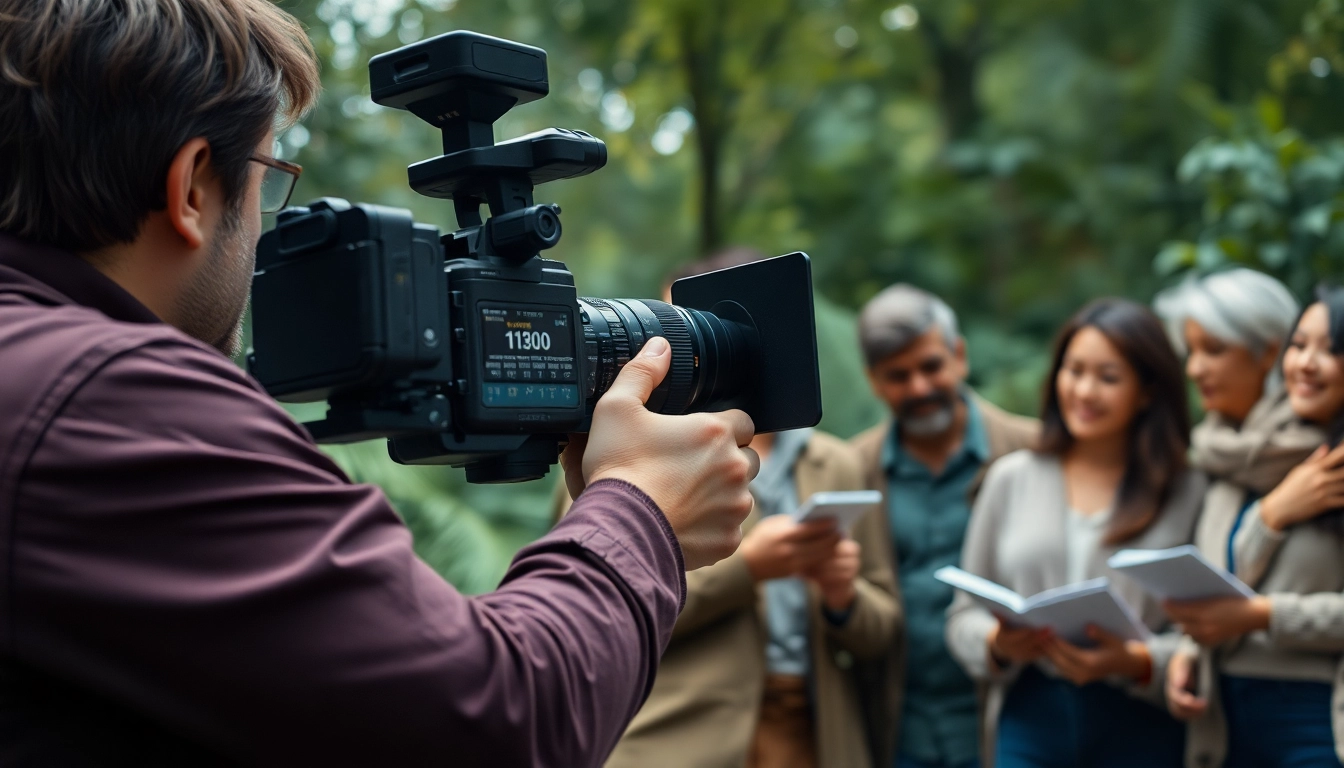Understanding the Foundations of Storytelling & Documentary
The Essence of Storytelling & Documentary
At its core, storytelling is an intrinsic part of human culture, seamlessly integrated into our social fabric. It allows us to share experiences, convey emotions, and navigate the complexities of life. When combined with the documentary genre, storytelling evolves into a powerful tool for revealing truths and making sense of the world around us. Thus, the realm of Storytelling & Documentary becomes not only an art form but also a vehicle for education and influence.
Historical Context and Evolution
The documentary genre has undergone significant transformations since its inception in the late 19th century. Early documentaries, often referred to as “actualities,” were simple recordings of everyday life. As technology advanced and filmmakers began experimenting with narrative structures and techniques, documentaries morphed into a distinct style of storytelling. The emergence of sound, color, and digital cinematography opened new avenues for expression, enabling creators to blend facts with compelling narratives.
From Robert Flaherty’s groundbreaking film *Nanook of the North*, which humanized its subjects, to the impactful documentaries of today that tackle social issues and environmental crises, this evolution illustrates how documentary filmmaking has continuously adapted to reflect the realities of society and technological advancement.
The Role of Truth in Documentary
The quest for truth lies at the heart of documentary storytelling. Unlike fiction, documentaries aim to represent reality, creating an authentic connection with the audience. Nevertheless, truth in documentary is nuanced, often influenced by the filmmaker’s perspective, choices in framing, and editing. The line between objective representation and creative interpretation can be challenging to navigate.
Responsible filmmakers acknowledge this complexity by striving for transparency in their work. This dialogue about truth challenges viewers to engage critically with the content, fostering a deeper understanding of the subjects explored and igniting reflection on broader societal issues.
Core Techniques in Storytelling & Documentary Filmmaking
Visual Storytelling: Techniques and Approaches
Visual storytelling is fundamental in documentaries, as it allows filmmakers to convey complex ideas and emotions through imagery. Techniques such as framing, composition, and color grading significantly impact how audiences interpret a story. For instance, the decision to use wide shots can evoke a sense of space or isolation, while close-ups can highlight emotional nuances in a subject’s expression.
Furthermore, the use of b-roll footage can enhance narrative depth. By interspersing relevant visuals with interviews or voiceovers, filmmakers create a rich tapestry that immerses viewers in the story. Edits should be employed thoughtfully, allowing transitions to deliver emotional weight or to underscore pivotal moments in the narrative.
Structuring Your Documentary Narrative
Like traditional storytelling, documentaries thrive on structure. Common frameworks include the three-act structure, which segments narratives into setup, confrontation, and resolution. This familiar framework helps viewers navigate the story, providing a predictable yet engaging flow of information.
Additionally, utilizing a thematic structure can reinforce the documentary’s message. By organizing the content around key themes or questions, filmmakers invite viewers to explore different facets of a topic, fostering a more profound engagement with the material. This layered approach can make even complex subjects accessible to broader audiences.
Interview Techniques and Audience Engagement
Interviews are a cornerstone of documentary storytelling, providing insight directly from subjects about their experiences and perspectives. Effective interview techniques involve careful preparation, including developing questions that allow for open dialogue and emotional expression while avoiding leading prompts that can distort the narrative.
Building rapport with interviewees is essential in creating a comfortable environment where genuine moments can unfold. Filmmakers should cultivate trust and demonstrate respect for their subjects, recognizing that the resulting narratives have real-world implications.
Crafting Emotional Resonance in Storytelling & Documentary
Using Music and Sound to Enhance Emotion
Sound design is a powerful tool in documentary filmmaking, capable of evoking emotion and enhancing the overall narrative. The strategic use of music can create tension, joy, or sorrow, shaping the viewer’s emotional experience. Moreover, the integration of ambient sounds contributes to immersing the audience in the film’s world, grounding their experience and increasing empathy for the subjects presented.
Filmmakers should consider the role of silence as well. Quiet moments can allow viewers to reflect, creating space for emotional depth and connection. When employed effectively, sound design becomes an integral character in the documentary, guiding the audience’s journey through the narrative.
Creating Relatable Characters and Authentic Voices
Documentaries shine when they feature relatable characters who resonate with audiences. A thoughtful approach to character development is critical, particularly when selecting subjects who embody themes or messages the filmmaker seeks to communicate. Authentic voices contribute to the credibility and emotional impact of the documentary, fostering a sense of connection between the characters and the viewers.
Understanding a character’s background, motivations, and struggles not only enhances storytelling but also allows the audience to engage with the subject matter on a personal level. When the narratives conveyed are genuine and well-researched, viewers are more likely to empathize and invest emotionally in the outcome of the story.
Symbolism and Visual Metaphors in Storytelling
Symbolism and visual metaphors enrich documentary narratives, adding layers of meaning that prompt deeper reflection. By incorporating meaningful imagery, filmmakers can transcend literal interpretations, conveying abstract concepts through visual means. For instance, using recurring motifs or colors can signify recurring themes or emotional states within the narrative.
Exploring these creative elements fosters a more engaging viewing experience and allows the audience to interpret the material on multiple levels. This depth enhances the impact of documentaries, encouraging discussions that extend beyond the screen, prompting viewers to question their perspectives and societal contexts.
Distribution and Audience Engagement Strategies
Optimizing for Various Platforms
In the modern digital landscape, distribution strategies must align with where audiences consume content. Given the rise of streaming platforms and social media, filmmakers can reach global audiences more easily than ever. Tailoring the documentary format to various platforms—short-form for social media, enhanced features for streaming services—enables creators to maximize exposure and engagement.
Moreover, understanding the demographics and viewing habits of target audiences is crucial. Marketers can analyze which platforms yield the best results for specific content types, allowing them to focus their resources effectively and maximize impact.
Building a Community Around Your Documentary
Engaging audiences extends beyond passive viewing; it encompasses creating a community around the documentary. Filmmakers can leverage social media platforms, online forums, and screening events to foster dialogue and interaction with viewers. These spaces allow the audience to share reactions, interpretations, and discussions, enhancing the documentary’s relevance and reach.
Moreover, partnerships with advocacy groups and organizations can amplify the documentary’s message, uniting similar interests to inspire action based on the themes presented. By nurturing community involvement, filmmakers can cultivate invested audiences that carry the film’s message beyond its initial viewing, creating a ripple effect of awareness and engagement.
Metrics for Measuring Impact and Reach
Assessing the impact of a documentary requires a comprehensive approach to metrics, considering both qualitative and quantitative feedback. Viewership statistics provide baseline data on engagement levels, while viewer feedback helps uncover emotional resonance and societal impact.
Filmmakers and marketers should analyze how viewers interact with the documentary, including social media engagement, discussions generated, and initiatives inspired by the film. Surveys and interviews with audiences post-viewing can yield insights into the perceived significance of the documentary, guiding future projects and contributing to ongoing conversations related to the documentary’s themes.
Future Trends in Storytelling & Documentary
The Impact of Technology on Storytelling
Technology continues to reshape the landscape of documentary filmmaking. With advancements in virtual reality (VR), augmented reality (AR), and high-quality digital imaging, filmmakers can create immersive experiences that engage audiences in new and innovative ways. These technologies invite viewers to participate in storytelling, offering perspectives that traditional documentary styles cannot provide.
Furthermore, data analytics tools enable creators to understand audience behavior and preferences, allowing for tailored content that resonates on a more profound level. This data-driven approach supports substantial engagement while fostering creative evolution in documentary storytelling.
Interactive Storytelling in Documentaries
Interactive documentaries present a unique evolution of narrative storytelling, providing viewers with agency in their viewing experience. Unlike traditional formats, interactive documentaries allow audiences to make choices that affect the narrative path, promoting personalized engagement and deeper connections with the content.
Such approaches can enhance the learning experience, allowing users to explore topics at their own pace and deepen their understanding. The integration of interactivity exemplifies how documentaries can adapt to changing audience expectations, focusing on engagement and participatory experiences.
Ethical Considerations for Modern Filmmakers
The ethics of documentary filmmaking continues to evolve alongside technology and societal shifts. Modern filmmakers face numerous ethical dilemmas, including representation, consent, and the impact of their work on the subjects they portray. Transparent practices, such as obtaining informed consent and communicating the potential implications of being part of a documentary, have become increasingly vital.
These considerations emphasize the importance of empathy, responsibility, and respect in the creative process. Filmmakers must strive to encourage positive dialogue, empowering their subjects and acknowledging the real-world implications of their work. By adhering to ethical principles, filmmakers can contribute to authentic storytelling that honors the humanity of everyone involved.



